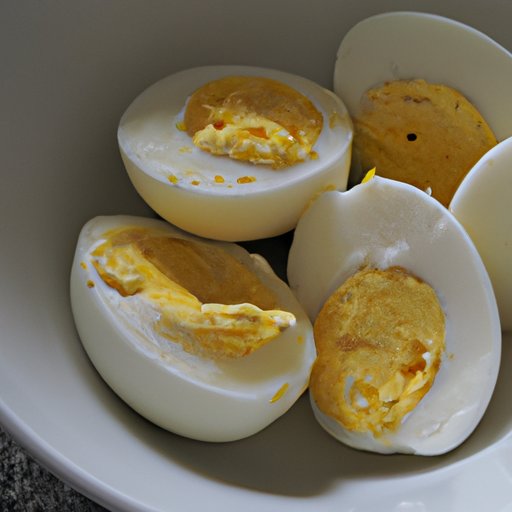
I. Introduction
Hard boiled eggs are a breakfast staple and a popular ingredient in many recipes. However, achieving the perfect hard boiled egg can be a challenge. From undercooked yolks to shells that won’t peel, there are many obstacles to overcome. In this article, we’ll provide you with a step-by-step guide to making the perfect hard boiled egg. We’ll also give you tips and tricks for experimentation, share some delicious breakfast recipes that feature hard boiled eggs, and compare them to their softer counterparts. Read on to discover how to make the perfect hard boiled egg!
II. Step-by-Step Instructions
To make the perfect hard boiled egg, you’ll need a few pieces of equipment: a saucepan, water, and eggs. Place the eggs in a single layer in the saucepan, then add enough water to cover them by about an inch. Place the saucepan over high heat and bring the water to a rolling boil. Once the water is boiling, lower the heat to a simmer and set a timer for exactly 12 minutes.
Once the timer goes off, remove the saucepan from the heat and immediately transfer the eggs to a bowl of ice water. This will stop the cooking process and prevent the eggs from overcooking. Let the eggs sit in the ice water for at least 5 minutes, then remove and store in the refrigerator until ready to use.
Here are a few tips and tricks to ensure perfectly boiled eggs:
- Use eggs that are at least a week old. Fresh eggs are harder to peel, so older eggs work best.
- Add a teaspoon of vinegar to the water. This can help prevent the egg whites from seeping out if any shells crack.
- Don’t overcrowd the saucepan. The eggs should be in a single layer with enough room to move around slightly while boiling.
- Test for doneness by spinning the egg. Once fully cooked, the yolk should remain in the center of the egg. An undercooked egg will have a loose yolk that easily moves around.
III. Experimentation
If you’re looking for something a little different, don’t be afraid to experiment with different cooking times and techniques! Try pre-boiling your eggs in a separate saucepan filled with hot water, or cooking them for a shorter amount of time. You can also try steaming your eggs or cooking them in a slow cooker. Experimenting with different techniques will help you find the perfect recipe that works for you.
IV. Breakfast Recipes
Hard boiled eggs are a versatile ingredient that can be used in a variety of breakfast recipes. Here are a few of our favorites:
Classic Deviled Eggs
Start by cutting your hard boiled eggs in half lengthwise. Remove the yolks and mash them in a bowl with mayonnaise, mustard, salt, and pepper. Spoon the mixture back into the egg white halves, then top with paprika.
Egg Salad Sandwiches
Mix chopped hard boiled eggs with mayonnaise, Dijon mustard, celery, salt, and pepper. Toast two slices of bread, then spread the egg salad on one slice and top with lettuce and the other slice of bread.
Cobb Salad
Toss mixed greens, chopped tomatoes, avocado, bacon, crumbled blue cheese, and diced cooked chicken in a large bowl. Top with sliced hard boiled eggs and your favorite salad dressing.
V. Comparison to Soft Boiled Eggs
While hard boiled eggs are a breakfast classic, soft boiled eggs are a great option for a runnier, creamier egg. To make a soft boiled egg, bring a saucepan of water to a boil, then lower the heat to a simmer. Gently lower your eggs into the water and cook for 6 minutes. Once done, immediately transfer your eggs to a bowl of ice water and let cool for 1-2 minutes before peeling and serving.
While soft boiled eggs require a shorter cooking time, they’re a bit trickier to make than hard boiled eggs. Soft boiled eggs need to be cooked just right in order to have a runny yolk, and overcooking them can easily lead to a solid yolk. However, if you’re looking for a creamier egg to serve with toast or in a ramen bowl, soft boiled eggs may be the perfect choice for you.
VI. Omelet and Frittata Recipes
Hard boiled eggs can also be used as an ingredient in omelets and frittatas to add texture and nutritional benefits. Here are a few ideas:
Spinach and Feta Frittata
Sauté spinach and onion in a skillet until wilted. Whisk together 6 eggs, 1/4 cup milk, chopped hard boiled eggs, and crumbled feta cheese. Pour the mixture over the spinach and onion and cook on low heat until the eggs are just set. Broil for 2-3 minutes until the top is golden brown.
Egg and Bacon Omelet
Cook diced bacon in a skillet until crispy, then set aside. Whisk together 2 eggs, salt, and pepper. Pour the egg mixture into the skillet with the bacon and cook until the eggs are set. Layer chopped hard boiled eggs on one half of the omelet, then fold the other half over and slide onto a plate.
VII. Conclusion
Now that you know how to make the perfect hard boiled egg, the possibilities are endless! Experiment with different techniques and cooking times to find your perfect recipe. Don’t be afraid to incorporate hard boiled eggs into your breakfast and brunch routine with our delicious breakfast recipes. Whether you prefer a classic deviled egg or a protein-packed frittata, hard boiled eggs provide a nutritious and versatile ingredient for any meal.




